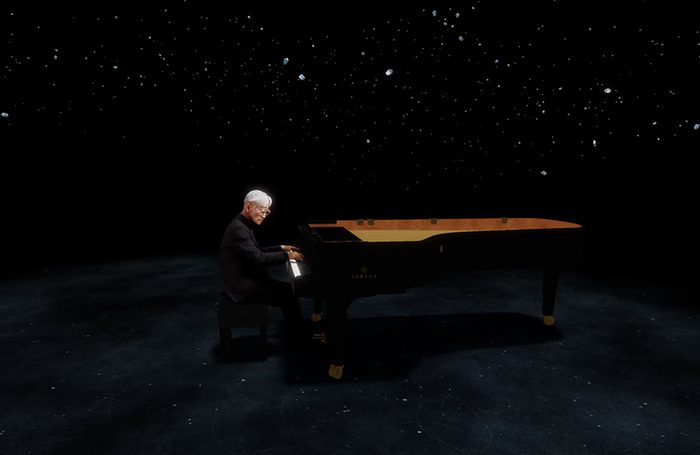Ryuichi Sakamoto was a Japanese composer and pianist who died in 2023. Yet here he is playing on a stately grand piano in the middle of the Roundhouse.
Knowing he was going to die, Sakamoto worked with Todd Eckert and his Tin Drum company, a group of ‘mixed reality pioneers’ of artists and technolologists. Together they produce a performance which the audience views via a headset of ‘mixed reality’ glasses which allow them to see the artist and surrounding artworks. As Sakamoto wrote ‘This virtual me will not age, and will continue to play the piano for years, decades, centuries. Will there be humans then?’
First, the audience is ushered through white shroud-like curtains into a space where huge black and white photographs of Sakamoto line the walls showing pivotal stages of his life in New York City and his Academy Award presentation for the score for The Last Emperor. On the end wall is a film of him working at home exploring sounds which will influence his music – at home in his garden in the rain with a bucket on his head, then trudging through the snow in the arctic circle to take recordings of the water flowing under ice which he calls ‘fishing for sound.’
Once in the circular auditorium the audience are seated around the outside and fitted with ‘mixed reality’ headsets. As we face the centre, the 3D vision of Sakamoto appears seated at his piano as he tenderly plays his ten pieces. Clouds float under his feet giving the impression of him floating in the sky.
I was expecting an immersive experience of art dripping down the walls, but it was more of a piano recital with a show of earthy elements connecting us to the essence of Sakamoto’s music. Around, above and below the player are different images: of falling leaves, snow and walls of stone. These elements are reflected in his slow and thoughtful music. At one point, he plays a more aggressive piece conveying the business of urban life as a Tokyo cityscape circles around him. Near the end, the globe of the earth as seen from space appears below the performer against a background of galaxies of stars fitting Sakamoto into the universe to which he belongs.
Kagami (which means mirror in Japanese) is a very different theatrical experience. It is a clever performance of contemporary music and art, but I can’t say I was moved. A depth is added by the nature of the technology itself which allows us to see the virtually real image, but not the other people in the audience as we walk around Sakamoto, seeing him from all sides. It seems we are the ghosts, looking right through other people at the spectral piano player who is visible to all of us. It is as if we are not there, while Sakomoto so clearly is.
Sakamoto is a consummate professional, an intense elegant man at the height of his powers. We bring to the performance the knowledge that the person we are seeing knows he is soon to die and has created this performance for us, which adds a poignancy to the event.

